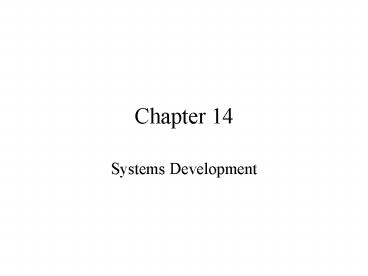Systems Development - PowerPoint PPT Presentation
Title:
Systems Development
Description:
Chapter 14 Systems Development Agenda Reasons for Change System Development Life Cycle (SDLC) Prototyping Rapid Application Development (RAD) Object Oriented ... – PowerPoint PPT presentation
Number of Views:221
Avg rating:3.0/5.0
Title: Systems Development
1
Chapter 14
- Systems Development
2
Agenda
- Reasons for Change
- System Development Life Cycle (SDLC)
- Prototyping
- Rapid Application Development (RAD)
- Object Oriented Development
- End User Development
- Issues
- FHC System Proposal
3
Reasons for Change
- Deterioration
(legacy systems) - Technology
- User expectations
- Keep up with competition
- External forces
- Merger / takeover
- Government regulation
4
IT Life Cycle
- Analysis and design
- Implementation
- Maintenance
- Deterioration or obsolete
5
Development Method
- System development life cycle (SDLC)
- Prototyping
- Rapid application development (RAD)
- Object oriented development
- End user development
- Outsourcing
6
Agenda
- Reasons for Change
- System Development Life Cycle (SDLC)
- Prototyping
- Rapid Application Development (RAD)
- Object Oriented Development
- End User Development
- Issues
- FHC System Proposal
7
System Development Life Cycle (SDLC)
- Distinct IS project segments
- Different with each organization
- Each segment has
- start and end dates
- deliverable
8
System Development Life Cycle
- Feasibility study
- Technology, Economics, organizational factors,
legal, ethical, and other constraints - Analysis and design
- User requirements input, output, storage
- Acquisition or development
- Programming, testing, documenting
9
System Development Life Cycle
- Implementation
- Parallel conversion, direct cutover, pilot
conversion, phased or modular conversion - Operation
- Post-audit
- System performance
- Maintenance
- Minor changes
10
Agenda
- Reasons for Change
- System Development Life Cycle (SDLC)
- Prototyping
- Rapid Application Development (RAD)
- Object Oriented Development
- End User Development
- Issues
- FHC System Proposal
11
Prototyping
- Model of final IS
- Reasons
- 4GLs
- PCs
- Failure of classic approach
12
Prototype Life Cycle
Analyze problem
Develop Prototype
Operationalize Prototype
Refine Prototype
Complete System
13
Prototyping Types
- Operational prototype or production prototype
- Throwaway prototype
14
Advantages
- User oriented
- What the user sees
- Not enigmatic diagrams
- Quicker error feedback
- Earlier training
15
Disadvantages
- User expectations
- Bypass analysis
- Documentation
- Never ending
16
Agenda
- Reasons for Change
- System Development Life Cycle (SDLC)
- Prototyping
- Rapid Application Development (RAD)
- Object Oriented Development
- End User Development
- Issues
- FHC System Proposal
17
Rapid Application Development
- Special case of Prototyping
- Components
- GUI development environment
- Reusable components
- Code generator
- Object oriented programming language
18
Advantages
- Speed
- Portability
- Maintainability and modifiability
- Data oriented systems
19
Disadvantages
- Never ending
- Lack of documentation
- Inadequate analysis
20
Agenda
- Reasons for Change
- System Development Life Cycle (SDLC)
- Prototyping
- Rapid Application Development (RAD)
- Objective Oriented Development
- End User Development
- Issues
- FHC System Proposal
21
Object Oriented Development
- Reusable IS components
- Small, self-contained program modules
- Includes
- Operations
- Data
22
Advantages
- Easier to build and maintain (object)
- Reusable codes
- Flexible for adding and changing objects
- User oriented
- Increase productivity and quality (programmer)
- Increase productivity and quality
- Web application
23
Disadvantage
- Complex
- Lack of experts
24
Agenda
- Reasons for Change
- System Development Life Cycle (SDLC)
- Prototyping
- Rapid Application Development (RAD)
- Object Oriented Development
- End User Development
- Issues
- FHC System Proposal
25
End User Development
- Reasons
- Powerful PC
- Cheaper hardware
- Software capability
- Computer literate
- IS backlog
- Small application
26
Advantages
- User control
- Business oriented
- Cost saving
- Development speed
27
Disadvantages
- Cost (hardware and software)
- Lack of analysis
- Lack of testing
- No documentation
- Duplication effort
- Security
- Backup and recovery
28
Points to Remember
- Reasons for Change
- System Development Life Cycle (SDLC)
- Prototyping
- Rapid Application Development (RAD)
- Object Oriented Development
- End User Development
29
Discussion Questions
- Will applications programmers and systems
analysts become nothing more than evaluators of
packaged software? - How do you measure System Effectiveness in
your organization? - How can you tell when a system is successful?
- unsuccessful?
- How do you decide that a system needs rework?
30
Assignment
- Review chapters 8-14 technology
- Read chapter 15
- Group assignment
- Research paper































